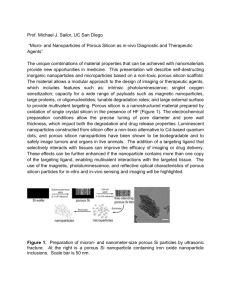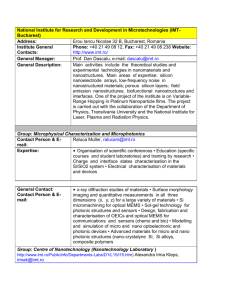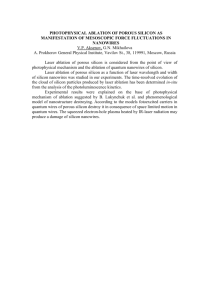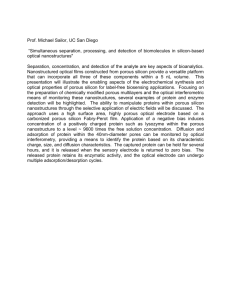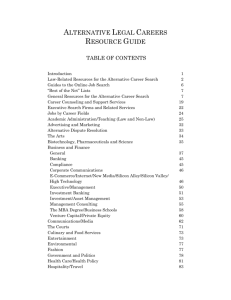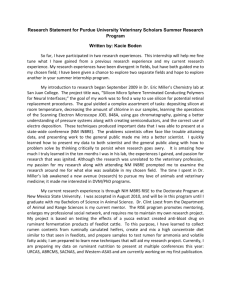Porous Silicon
advertisement
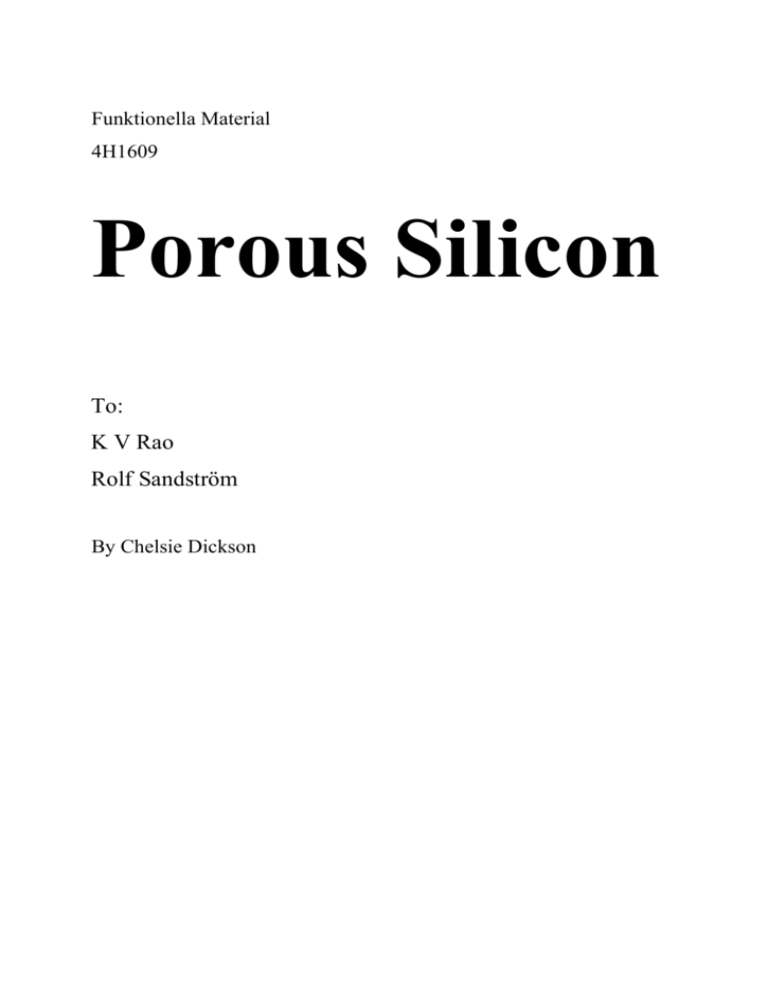
Funktionella Material 4H1609 Porous Silicon To: K V Rao Rolf Sandström By Chelsie Dickson Abstract Since Legh Canham’s discovery that porous Silicon shows Luminescence in room temperature, thousands of papers have been published related to its chemical or physical properties. The material has found important application in a wide area, electronics, medicine, sensor etc. The property to be a luminance material has open wide new applications for porous Silicon, nor only in the electro science but also in the biomedicine- and sensor areas. The Silicon wafer is dissolved in a hydrogen and fluorine solution where etching occurs if current flows throw the material. Pores forms unidirectional to the Silicon surface, but Silicon’s property to be a semiconductor is still remaining, and know the Silicon can be used in a wide knew applications. The report have been written so as many as possible will be able to read and understand the fundamentals of porous Silicon. 2 Contents page 1. Introduction 4 1.1 Silicon 4 1.2 History 5 2. Fundamental Background 6 2.1 The structure of porous Silicon 6 2.2 Formation of porous Silicon 7 2.3 The porosity 10 3. Properties 11 3.1 Luminescence 11 4. Application 12 4.1 Optical properties 12 4.2 Reflectors 13 4.3 Biocompatibility 14 4.4 Sensor 15 4.4.1 Humidity sensor 16 4.4.2 Gas sensor 17 4.4.3 Analytical chemistry porosity sensors 18 Footnote 19 Reference 20 3 1. Introduction 1.1 Silicon Silicon is a nonmetallic chemical element in the carbon family (Group IVa of the periodic table). Silicon makes up 27.7 percent of the Earth's crust and it is the second most abundant element in the crust, being surpassed only by oxygen. Silicon was first isolated and described as an element in 1824 by Jöns Jacob Berzelius, a Swedish chemist. Silicon does not occur uncombined in nature; but it is found in practically all rocks as well as in sand, clays, and soils, combined either with oxygen as silica (SiO2, Silicon dioxide) or with oxygen and other elements (e.g., aluminum, magnesium, calcium, sodium, potassium, or iron) as silicates. Its compounds also occur in all natural waters, in the atmosphere (as siliceous dust), in many plants, and in the skeletons, tissues, and body fluids of some animals. Pure Silicon is a hard, dark gray solid with a metallic luster and with a crystalline structure the same as that of the diamond form of carbon, to which Silicon shows many chemical and physical similarities. A brown, powdery form of Silicon has been described that also has a microcrystalline structure. The element is prepared commercially by reducing the oxide by its reaction with coke in electric furnaces. Silicon's atomic structure makes it an extremely important semiconductor1; highly purified Silicon, doped with such elements as boron, phosphorus, and arsenic, is the basic material used in computer chips, transistors, Silicon diodes, and various other electronic circuits and switching devices. Three stable isotopes of Silicon are known: Silicon-28, which makes up 92.21 percent of the element in nature; Silicon-29, 4.70 percent; and Silicon-30, 3.09 percent. Five radioactive isotopes are known [1]. Pure Silicon 1. Semiconductor A class of crystalline solids intermediate in electrical conductivity between a conductor and an insulator. Such a material can be treated chemically to transmit and control an electric current. Semiconductors are employed in the manufacture of various kinds of electronic devices, including diodes, transistors, and integrated circuits [1]. 4 1.2 History Year 1824 become Silicon classifies to a soil by the Swedish chemist Jöns Jacob Berzelius, a Swedish chemist. But since the original observation by Uhlir in 1956, that Silicon could be porous by an anodic dissolution there have been a large amount of work directed towards the understanding of the structural properties of the porous material [2]. A big discovery by Leigh Canham in 1990 changed the whole sight to porous Silicon. He was the first man to discover the photoluminescence property of porous Silicon. After this most important discovery there have been thousands of paper published related to its chemical or physical properties. The materials have found important application in a wide area, electronics, medicine, sensor etc. Figure 1: The structure of pure Silicon 5 2. Fundamental Background 2.1 The structure of porous Silicon Porous Silicon is a complex material, which one would characterize by a hierarchy disorder. The internal arrangement of Silicon atoms is believed to be the same as the diamond like structure of crystalline Silicon. But one must accept a fair number of native defects: vacancies disvacancies, multivacancies and concomitant dangling bonds with bond rearrangement. The nanocrystallites occurs in two forms, columnar or dots (spheres) or a mixture of both. However the surface is smooth. It is highly irregular and the surface area2 is large. The nanocrystallites may come in a variety of shapes and a range of sizes from 2 nm to 10 nm, these are not arranged with intermediary spaces, the crystalline is brittle, spongy skeleton, that is why the name Porous Silicon is used [3]. Figure 2: Cross section of the pore structure in nanocrystalline porous Silicon 2 Surface Area In general, the surface area is the sum of all the areas of all the shapes that cover the surface of the object . 6 2.2 Formation of porous Silicon Porous Silicon is manufactured by the electrochemical dissolution of Silicon in a solution. Dissolving a bulk Silicon wafer in an electrochemical cell containing hydrogen fluoride solution makes porous Silicon. Figure 3 shows two different etch methods. The remaining porous layer is a complicated network of Silicon wires each with a thickness of between 2-5 nm (20,000 times thinner than a human hair). Normally, Silicon does not dissolve but if a current flows through the interface of the crystal and the solution, electrochemical etching will occur. This dissolution is only possible when the current delivers electric carriers (holes) to the interface. This is the case when the Silicon wafer is the anode of the electrochemical process. For this reason, the etching of porous Silicon is called anodization. Figure 3: Standard methods for producing porous Silicon: a) etching in a PTFE etching cell (dry etching process); and b) the stain etch process. If a high current density is applied, the electrochemical dissolution of Silicon in hydrogen fluoride will generate a very smooth surface. This process is known as electro polishing. On the other hand, if the current density is smaller, pores are etched into the Silicon. Figure 4 shows the interface of the Silicon to the solution. If a high current density is applied, there are many holes at the surface. The etching is limited by the diffusion of the fluorine ions. These ions migrate in the electric field. If the surface has an outgrowth will this preferentially be etched. This way the surface is smoothed but also leads to a surface charge of holes. This is the case of electro polishing. 7 The case of low current density is visual on the right in the figure. We find enough fluorine ions but few holes. The etching is limited by the vacancy diffusion. If the surface has a cavity, the holes will be forced to go there by the electric field. In this way the cavity will be enlarged to form a pore. The tip of the pore is preferentially etched, while etching of the pore walls is unlikely. Actually there are some possible mechanisms, which spoil the etching of the pore walls. They determine the different morphologies of porous Silicon [6]. FFF- - FF- Silicon electrolyte High current density Silicon electrolyte Low current density Figure 4: The interface of the Silicon in the solution if a high or low current is applied. 1) A surface region that is depleted of mobile charge carriers (space charge regions) will form if a semiconductor electrode is in contact with the electrolyte. Under anodic bias this layer is thick (several μ) for low doped n-type3 and it is thin for highly doped p- or n-type. The depletion region width and the mechanism of charge transfer determine the size of the pores. In highly doped materials this transfer is dominated by tunneling of charge carriers, in this case the pore size scales with the depletion region with and is about 10 nm. In moderately doped n-type material charge carriers may be generated by breakdown. This requires fine pore tips, consequently the pore diameter will be about 10-50 nm independently of doping density. These pores are designated meso-pores. If holes are generated in n-type Silicon by illumination pore diameter from 0,05 up to 20 μm depending on doping density and formation conditions will be observed. These pores are designated macro pores. 3 P-doped and N-doped An atom of silicon has four electrons in its valence band - the outer band of electrons that's the most important. A crystal of pure silicon is a regular array, or lattice, of such atoms. When a crystal is doped with arsenic, some silicon atoms are replaced by arsenic atoms, which have five valence electrons. The “extra” electron moves into the conduction band and can carry current. Such doped semiconductors are called n-type. If a crystal is doped with boron, which only has three valence electrons, holes are introduced into the crystals. These can 'jump' from atom to atom carrying current. These are called p-type semiconductors [1]. 8 2) A depletion of holes is also expected, if the dimensions of a semiconductor particle, wire or sheet are below the Bohr radius of an exiton (a few nm). In this case holes are depleted independently of the doping density of the substrate due to quantum confinement. These small pores are designated micropores and will be found on all Silicon anodes independently of doping density. Both mechanisms are self-adjusting; this means that the average size of pores and the separating wall is determined by the formation mechanism. And both mechanisms are independent of each and other and may coexist, resulting in a superposition of micropores and meso- macroporous Silicon structures[2, p2]. The flowchart in figure 5 shows which kind of porous structure can be expected under given conditions. Figure 5: Diagram ”Anodic voltage vs characteristic porosity parameter” showing possible types of morphology according to the model. Different pore sizes and morphologies suit different molecules, so these can be tailored to the sensing capability required. (Pores of 1–30 nm in diameter, for instance, offer the best sensitivity to humidity.) Moreover, it has proven practical to produce pores of graded size on the same substrate to achieve multiple targets sensing capability on the same chip [7]. 9 2.3 The Porosity The porosity of a sample is defined as the amount of air in the material after processing has finished, so 45% porous sample would contain 45% air and 55% Silicon [6]. During manufacture, porous layers of a few microns to 100μm thick are etched into bulk Silicon, doped or undoped. Cross-sectional scanning electron micrographs of porous Silicon show that pore formation occurs unidirectional from the surface into the bulk, leaving aligned pores and columnar structure. So fine is the control that can be achieved by specifying particular etching parameters that micropores, mesopores or macropores can be created. The pore sizes are categories by looking only at parameters (average) pore diameter and (average) distance between pores, i.e. at the geometry of the pores. Micropores, with pore diameters and pore distances (from now on subsumed under "geometries") <10 nm. Mesopores, with geometries in the 10–50 nm region. Macropores with geometries in the >50 nm region. Formation and application of Different pore sizes and morphologies suit different molecules, so these can be tailored to the sensing capability required. Figure 6 shows some different pore geometry and sizes. Figure 6: Some examples demonstrating the variety of pores found in Si: (a) seeded n-macropores , (b) random n-macropore, (c) n-macropores, (d) p-macropores, (e) n-macropores as seen in pore growth direction by TEM, (f) n+-macropores, (g) n-macropores, (h) n-macropores, (i) n-macropores) [7]. 10 3. Properties 3.1 Luminescence The interest of porous Silicon rose sharply in 1990 when Canham demonstrated that high porosity layers could photoluminescence efficiently at room temperature and attributed this phenomenon to the formation of a surface passivated Silicon quantum array. Although Silicon is an indirect band gap semiconductor, porous Silicon shows strong photoand electroluminescence4. During the last years great progress in the understanding of the luminescence mechanism has been achieved. A lot of experiments show that the nanocrystalline nature of porous Silicon is responsible for the luminecences. Due to the small crystal sizes, less than 40 Å, the properties of porous Silicon are dominated by quantization effects. In a study it was shown that nanocrystals with diameters around 25 Å are the major origin of the photoluminescence. Such small crystals dominate the microstructure in porous Silicon, which have high porosity (~70%) and formed on low p-type doped substrates. These porous Silicon films also exhibit a very high specific surface (400-600m2/cm3) [2, p75]. Figure 7: Two glowing porous Si wafers, photographed under ultraviolet illumination. The luminescence arises from Silicon nanocrystallites contained in the porous matrix. The wafer on the left has a drop of pure water on its surface; the one on the right has a drop of 20% aqueous ethanol (40-proof alcohol). When the ethanol and water dry off, both wafers glow with the same intensity. This illustrates a potential application for porous Silicon as a reversible chemical sensor for alcohol. 4 Luminescence The excitation energy is transferred to the electrons responsible for luminescence, which jump from their ground-state energy level to a level of higher energy. The energy levels that electrons can assume are specified by quantum mechanical laws. The different excitation mechanisms considered below depend on whether or not the excitation of electrons occurs in single atoms, in single molecules, in combinations of molecules, or in a crystal. They are initiated by the means of excitation described above: impact of accelerated particles such as electrons, positive ions, or photons. Often, the excitation energies are considerably higher than those necessary to lift electrons to a radiative level. The colour of the luminescent light is nearly independent of the energy of the exciting particles, depending chiefly on the excited-state energy level of the crystal centres [1]. 11 4. Application Porous Silicon has gained wide attention over the last decade for its interesting material properties: nanometer features and extremely high specific surface area. Application are, amongst others, humidity sensors, optical elements or biochemical matrices. 4.1 Optical properties Porous Silicon is an interesting optical material that has been researched intensively for over a decade. The most attractive property of porous Silicon is its room temperature luminescence, which is due to the confinement of charge carriers. Porous Silicon consists of a matrix containing a range of Silicon nanocrystal sizes. The size distribution of the nanocrystals is responsible for porous Silicon’s characteristic broad band luminescence. Precise control of the emission wavelength and spectral width of the luminescence are crucial for optoelectronic applications [7] Light emission from porous Silicon occurs mainly in the visible region of the electromagnetic spectrum. The emission has the unique property that simply increasing or decreasing the porosity of the material can change the wavelength of the emitted light, see figure 8. For example, a highly porous sample (70-80% porosity) will emit green/blue light while a less porous sample (40%) will emit red light. Figure 8: This image shows four different types of porous Silicon, where the pore size is varied. Thus, since pore size determines the luminescence spectrum the chips are different colors. (Courtesy Rochester University.) 12 Work has been done for the investigation of photonic band gap effect in microstructured and macroporous Silicon. In this case the electrochemical etching of Silicon is used to produce columnar voids within Silicon wafers which can display very high aspect ratios. Suitable arrangement of the voids in a hexagonal pattern on the etched crystal will yield photonic band gap effects for the resulting photonic crystal. Full investigation of the optical properties of photonic crystals within Silicon is just examined. Once photonic crystals have been produced, it then becomes possible to investigate the fundamental solid state interactions occurring in the optically modulated crystal. As the wavelength at which photonic band effects have been observed moves into the visible part of the optical spectrum, so the fundamental processes to be observed in the presence of microstructuring become those for which the photonic bandgap energy approaches the electronic band gap energy of the carriers in the sculpted dielectric. In this regime it is anticipated that electron-photon and electron-phonon scattering will be heavily modified by the microstructure profile of the surrounding dielectric [8]. Porous Silicon multilayer structures are inexpensive, easily fabricated, and useful in a wide range of applications. 4.2 Reflectors It has been shown that porous Silicon can be used as a base material for passive or active optical devices like Bragg reflectors, Fabry–Perrot filters, planar waveguides, planar microactivities, etc. Because of its porous nature, the effective refractive index of porous Silicon is lower than that of bulk Silicon. Therefore, porous Silicon can also be used as an antireflection coating for Silicon solar cells. Pickering have shown that p-type porous Silicon thin layers can be described with a refractive index mainly dependent on the porosity. The possibility of covering a large range of refractive indexes n, from 1.25 to 3, was obtained. This allows many optical applications of this material [9]. 13 4.3 Biocompatibility Until recently, the amazing medical potential of Silicon was unrecognised. The scientists have now demonstrated that porous Silicon can be used to treat everything from broken bones to cancer. Porous Silicon compares favourably with titanium, ceramics, composites, polymers and others materials commonly used for biological implants. When Silicon is deliberately riddled with nanometre-sized holes it becomes biocompatible and biodegradable, the body will not reject it and it will dissolve harmlessly over time. Silicon chips had been implanted into the body before, for example in cochlear implants that convert sounds into electrical signals and feed them directly into the brain, but they had to be shielded from body tissues and the bloodstream. Porous Silicon needs no such protection. It can be crafted into orthopaedic and electronic structures and perform a variety of medical functions inside the body automatically. A Silicon implant can be crafted into temporary scaffolds or pins that will promote bone healing and growth and then dissolve into nothing. Alternatively, it can contain both a reservoir of drugs and a tiny computer system to control timing and dosage. It can even be used as an internal diagnostic device, transmitting data about a patient through his or her skin and enabling a doctor to fine-tune its drug-release program without the need for surgery. Other applications porous Silicon has as a biomaterial is the use of the material's reflectivity and its resistance to stomach acid. Silicon mirrors tucked under the skin will become more reflective according to the amount of cancer-related chemicals in the blood. These markers, currently measured in blood tests, indicate that a tumour is returning. Meanwhile, a pill made of Silicon could travel through the stomach without biodegrading and deliver potent drugs directly to the colon [11]. 14 4.4 Sensor Porous Silicon is a well-known material for sensing layer in different gas and humidity sensors. Owing to its very large surface area to volume ratio (>500 m2/cm3), Porous Silicon can absorb large amounts of foreign molecules on its surface. With the presence of these molecules, many properties associated with porous Silicon will change. For example, photoluminescence efficiency decreases when porous Silicon is exposed to various chemicals and the final photoluminescence efficiency depends on the dipole moment of the physically absorbed molecules. Likewise, the effective dielectric constant and conductivity of porous Silicon layer will change if the porous Silicon surface is saturated with some other molecules. Therefore, a capacitance-based or conductance-based humidity sensor can be realised using the relative change of dielectric constant or conductivity, respectively, when moisture is adsorbed on the surface of a porous Silicon layer [11] Figure 9:A porous Silicon sensor configuration designed for the detection of glucose. Gold interdigitated electrodes generated from photoluminescence-induced metallization are observed. Georgia Tech Photo: Gary Meek It has been found, for instance, that electro-depositing a coat of copper sulphide film into microporous Silicon provides a sensor that is responsive to ammonia, with much higher sensitivity than the semiconductor oxide and cuprous sulphide-based films that are used conventionally. Introducing dyes into the cavities is another technique that enhances sensitivity to specific molecules. 15 Another attraction of porous Silicon is that fabrication techniques can be easily adapted from those used by the microelectronics industry. High reactivity means that the material can easily be micromachined by etching and oxidization, and readily patterned by lithographic processes.You can fabricate it easily, pattern it in the same way, and integrate sensors with electronics in tiny, disposable devices [8]. 4.4.1 Humidity sensor Of the many sensors now in the advanced stages of development, paradoxically most do not rely on direct light emission. Humidity sensors, for example, are based on the change of either conductivity or dielectric constant that occurs when moisture is adsorbed. These porous Silicon devices are proving more sensitive than conventional ceramic elements that are established in this application, and offer other favourable characteristics including reproducibility, low hysteresis, short response time, good thermal tolerance, and low power requirement. Response is proportional to moisture content over a wide relative humidity range [8]. Figure 10:Capacitive humidity sensor A new type of humidity sensor with a very high sensitivity was developed making use of porous Silicon integrated as dielectrive in a capacitive sensor. Application areas are in: metrology, process industry, agriculture, etc [12]. For humidity sensing with ceramic layer, it is well known that both capacitance and conductance variation of a porous ceramic layer depends very much on the porosity of layer and the applied frequency. The size and distribution of pores of the ceramic humidity sensors also play very important role in determining the sensitivity and response time of a humidity sensor. Computer simulations for ceramic sensors indicate that micropores below 10 nm in diameter are slow in response while pore sizes between 1 and 30 nm are desirable for good sensitivity. 16 In a similar manner, the pore size and distribution of porous Silicon humidity sensor can be varied considerably by simply controlling its formation parameters like formation current density, hydrogen fluoride concentration, and illumination level. Also, porous Silicon is a nanostructured porous semiconductor having both capacitance and conductance that is significantly dependent on applied frequency of measurement. This is further aggravated by the unavoidable presence of parasitic capacitances and resistances arising out of the contacts between different layers and interconnects of the humidity sensor. The change in the measured capacitance and conductance of a porous Silicon humidity sensor would thus depend on the selection of the frequency of the signal source and the pore size and pore distribution of the porous Silicon layer. The contact geometry on the porous Silicon surface is also important and may influence considerably the measurement [11]. 4.4.2 Gas sensor Graded morphology is the key to multiple gas sensing capability within the same array, and the possibility of an “electronic nose”. Current multi-sensors relying on metal oxide semiconductors, gas sensitive field effect transistors or conducting polymers are generally inferior at detecting low concentrations in the presence of background odours. They are also bulky and rely on pattern recognition algorithms. A compact, sensitive porous Silicon-based electronic nose could bring greater reliability and repeatability into the professional sensing of food and wine odours, or other applications currently served by the human counterpart [8] Figure 11:Resistive gas sensor array 17 Gas detectors that are super-sensitive, but at the same time simple and cheap, could be based on resistive porous Silicon elements. Researchers at the University of Brescia, for example, have patented a technique using a porous Silicon membrane on an Alumina substrate, which can sense concentrations of nitrogen dioxide (NO2) of 100 parts per billion (ppb), and potentially as low as 20 ppb, with minimal interference from contaminant organic vapors. The work shows promise for inexpensive, selective sensors for NO2, capable of operating at low power and room temperature. Fluorphosphate detection, however, relies on optical interferometer in which regular (FabryPerot) fringe patterns formed when incoming white light fed through a porous Silicon filter fabricated on bulk Silicon is reflected back from both the porous Silicon interfaces –– that with bulk Silicon and with air. The filter consists of a porous Silicon layer with graded porosity and hence graded refractive index. A shift in the fringe pattern occurs when the porous Silicon's native Silicon hydride-terminated surfaces come into contact with a target vapour, the resulting surface modification altering the optical thickness of the porous Silicon layer. The degree of shift is a measure of this optical change and hence of the vapour concentration. Advantages of the method, apart from its relative simplicity, are that it is highly sensitive and can take place with the light source and detector located slightly away from the porous Silicon sensor. It therefore lends itself to non-contact on-line monitoring [8]. 4.4.3 Analytical chemistry porosity sensors One of the most important characteristics of the Porous Silicon films is its very large and reactive internal surface. So that, one should expect, that this internal surface would play an important role in those specific properties of porous Silicon films which make this material so different from bulk one. In the May 20 issue of the scientific journal Nature, Purdue University chemist Jillian Buriak with Jing Wei and Gary Siuzdak of the Scripps Research Institute describe how porous Silicon can be combined with mass spectrometry, a method used to identify the chemical nature of a substance, to streamline and automate the analysis of biological molecules. The technique provides new tools for pharmaceutical companies to analyse small molecules, and it may be incorporated into new technologies designed to put miniature laboratories on a computer chip. 18 Footnote [1] Encyclopedia Britannica online, http://search.eb.com/ [2] Daniel Bensabel, Leigh Canham, Stephen Ossicini, Optical properties of low Dimensional silicon structures, series E:aplies science – vol 244 [3] G.C. John V.A. Singh / physics report 263 (1195) 93-151 [4] W Lang ‘Silicon microstructuring technology’, IMIT institute for Micro-and information technology , 1995 [5] George Marsh, Porous silicon a useful imperfection, Materials Today, Volume 5, Issue 1, 1 January 2002, Pages 36-41, [6] http://www.bath.ac.uk/physics/groups/opto/psilicon.html [7] www.techfak.uni-kiel.de H. Föll, M. Christophersen, J. Carstensen and G. Hasse.Faculty of Engineering, University of Kiel, Kaiserstrasse 2, D-24143, Kiel, Germany [8] http://www.bath.ac.uk/physics/groups/opto/psilicon.html [9] V. M. Aroutiounian, K. R. Maroutyan, A. L. Zatikyan and K. J. Touryan, Calculations of the reflectance of porous silicon and other antireflection coating to silicon solar cells, Thin Solid Films, Volumes 403-404, 1 February 2002, Pages 517-521 [10]http://www.qinetiq.com/markets/health/biomaterials/case_study_porous_silicon_the_intel ligent_biomaterial/index.asp [11] J. Das, S. M. Hossain, S. Chakraborty and H. Saha, Role of parasitics in humidity sensing by porous silicon, Sensors and Actuators A: Physical, Volume 94, Issues 1-2, 31 October 2001, Pages 44-52 [12] http://www.indkont.chalmers.se/expert/offers.html 19 References Encyclopedia Britannica online, http://search.eb.com/ Daniel Bensabel, Leigh Canham, Stephen Ossicini, Optical properties of low Dimensional silicon structures, series E:aplies science – vol 244 G.C. John V.A. Singh / physics report 263 (1195) 93-151 7W Lang ‘Silicon microstructuring technology’, IMIT institute for Micro-and information technology , 1995 8George Marsh, Porous silicon a useful imperfection, Materials Today, Volume 5, Issue 1, 1 January 2002, Pages 36-41, http://www.bath.ac.uk/physics/groups/opto/psilicon.html H. Föll, M. Christophersen, J. Carstensen and G. Hasse.Faculty of Engineering, University of Kiel, Kaiserstrasse 2, D-24143, Kiel, Germany http://www.ece.rochester.edu/ http://www.bath.ac.uk/physics/groups/opto/psilicon.html V. M. Aroutiounian, K. R. Maroutyan, A. L. Zatikyan and K. J. Touryan, Calculations of the reflectance of porous silicon and other antireflection coating to silicon solar cells, Thin Solid Films, Volumes 403-404, 1 February 2002, Pages 517-521 http://www.qinetiq.com/markets/health/biomaterials/case_study_porous_silicon_the_intellige nt_biomaterial/index.asp J. Das, S. M. Hossain, S. Chakraborty and H. Saha, Role of parasitics in humidity sensing by porous silicon, Sensors and Actuators A: Physical, Volume 94, Issues 1-2, 31 October 2001, Pages 44-52 http://www.indkont.chalmers.se/expert/offers.html http://www.wspc.com.sg/books/materialsci/2241.html http://www.fys.uio.no/~esm/psi.html http://www.stanford.edu/~choihc/science.htm Porous silicon––mechanisms of growth and applications, Solid-State Electronics, Volume 43, Issue 6, June 1999, Pages 1121-1141 V. Parkhutik 20
